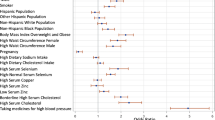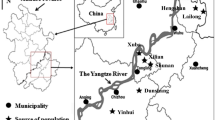Abstract
Background
Manganese (Mn) is an essential trace metal element required for optimal human health. However, few studies have assessed the Mn status in hypertensive patients, especially in China. Moreover, factors associated with Mn status have not yet been thoroughly explored. Therefore, we aimed to assess the serum Mn status of adults with hypertension in China and its association with demographic factors.
Methods
An observational, cross-sectional study was conducted to assess serum Mn concentrations in 14 provinces of China. A total of 2597 patients with hypertension were randomly identified by sex, age, and district, and serum Mn concentrations were quantified using inductively coupled plasma mass spectrometry (ICP-MS).
Results
In our study population, the median serum Mn levels were 1.60 (interquartile range (IQR), 0.94–2.85) µg/L for males and 1.51 (IQR, 0.86–2.69) µg/L for females. In adjusted linear regression models, significantly higher serum Mn concentrations were found in summer (compared with spring, β, 1.06 µg/L, 95% CI: 0.62 to 1.50), and those living in Guangxi (compared with Heilongjiang, β, 0.81, 95% CI: 0.06 to 1.56), Shanxi (compared with Heilongjiang, β, 0.75, 95% CI: 0.01 to 1.50), and Liaoning (compared with Heilongjiang, β, 1.65, 95% CI: 0.91 to 2.38), and significantly lower serum Mn concentrations were found in patients who aged 60–70 years (compared with those aged < 60 years, β, − 0.40 μg/L, 95% CI: − 0.76 to − 0.05).
Conclusion
Our findings observed high serum Mn status among Chinese adults with hypertension, and revealed the association between terms of age, region, and season with serum Mn.


Similar content being viewed by others
Data Availability
The data presented in this study are available upon request from the corresponding author. The data are not publicly available.
Change history
07 May 2022
A Correction to this paper has been published: https://doi.org/10.1007/s12011-022-03278-4
Abbreviations
- Mn:
-
Manganese
- ICP-MS:
-
Inductively coupled plasma mass spectrometry
- IQR:
-
Interquartile range
- PR:
-
Prevalence ratio
- CI:
-
Confidence interval
- tHcy:
-
Total homocysteine
- BMI:
-
Body mass index
- SBP:
-
Systolic blood pressure
- DBP:
-
Diastolic blood pressure
- AH:
-
Anhui
- BJ:
-
Beijing
- GS:
-
Gansu
- GX:
-
Guangxi
- HB:
-
Hebei
- HLJ:
-
Heilongjiang
- HN:
-
Hunan
- JS:
-
Jiangsu
- LN:
-
Liaoning
- NX:
-
Ningxia
- SD:
-
Shandong
- SX:
-
Shanxi
- SC:
-
Sichuan
- YN:
-
Yunnan
References
Roth GA et al (2017) Global, regional, and national burden of cardiovascular diseases for 10 causes, 1990 to 2015. J Am Coll Cardiol 70(1):1–25
Lu J et al (2017) Prevalence, awareness, treatment, and control of hypertension in China: data from 1·7 million adults in a population-based screening study (China PEACE Million Persons Project). Lancet 390(10112):2549–2558
Wang Z et al (2018) Status of hypertension in China: results from the China hypertension survey, 2012–2015. Circulation 137(22):2344–2356
Aschner JL, Aschner M (2005) Nutritional aspects of manganese homeostasis. Mol Aspects Med 26(4–5):353–362
Erikson KM et al (2007) Manganese neurotoxicity: a focus on the neonate. Pharmacol Ther 113(2):369–377
Aguirre JD, Culotta VC (2012) Battles with iron: manganese in oxidative stress protection. J Biol Chem 287(17):13541–13548
Lee YK et al (2015) Daily copper and manganese intakes and their relation to blood pressure in normotensive adults. Clin Nutr Res 4(4):259–266
Xu, J., et al., The association between blood metals and hypertension in the GuLF study. Environ Res, 2021. 202: p. 111734.
Li L, Yang X (2018) The essential element manganese, oxidative stress, and metabolic diseases: links and interactions. Oxid Med Cell Longev 2018:7580707
Dobson AW, Erikson KM, Aschner M (2004) Manganese neurotoxicity. Ann N Y Acad Sci 1012:115–128
Podkowińska, A. and D. Formanowicz, Chronic kidney disease as oxidative stress- and inflammatory-mediated cardiovascular disease. Antioxidants (Basel), 2020. 9(8).
Lee BK, Kim Y (2011) Relationship between blood manganese and blood pressure in the Korean general population according to KNHANES 2008. Environ Res 111(6):797–803
Gouaref I et al (2016) The link between trace elements and metabolic syndrome/oxidative stress in essential hypertension with or without type 2 diabetes. Ann Biol Clin (Paris) 74(2):233–243
Liu WM, Zhu ZG, Leng HX (2004) Analysis of the contents of K, Na, Ca, Mg, Zn, Cu, Fe and Mn in serum of middle and old-aged hypertension patients. Guang Pu Xue Yu Guang Pu Fen Xi 24(3):360–362
Zhang, Z., et al., Cross-sectional study: relationship between serum trace elements and hypertension. J Trace Elem Med Biol, 2022. 69: p. 126893.
Liu, L.S. and W.G.o.C.G.f.t.M.o. Hypertension, [2010 Chinese guidelines for the management of hypertension]. Zhonghua xin xue guan bing za zhi, 2011. 39(7): p. 579–615.
Cowan DM et al (2009) Manganese exposure among smelting workers: blood manganese-iron ratio as a novel tool for manganese exposure assessment. Biomarkers 14(1):3–16
Laohaudomchok W et al (2011) Toenail, blood, and urine as biomarkers of manganese exposure. J Occup Environ Med 53(5):506–510
O’Neal SL, Zheng W (2015) Manganese toxicity upon overexposure: a decade in review. Curr Environ Health Rep 2(3):315–328
Nelson K et al (1993) Manganese encephalopathy: utility of early magnetic resonance imaging. Br J Ind Med 50(6):510–513
Williams, M., et al., Agency for Toxic Substances and Disease Registry (ATSDR) toxicological profiles, in Toxicological profile for manganese. 2012, Agency for Toxic Substances and Disease Registry (US): Atlanta (GA).
Hoet P et al (2012) Manganese in plasma: a promising biomarker of exposure to Mn in welders. A pilot study Toxicol Lett 213(1):69–74
Greger JL (1999) Nutrition versus toxicology of manganese in humans: evaluation of potential biomarkers. Neurotoxicology 20(2–3):205–212
Mayo Clinic Laboratories, Manganese, Serum. https://www.mayocliniclabs.com/test-catalog/Clinical+and+Interpretive/8413.
Cabral M et al (2021) Trace element profile and incidence of type 2 diabetes, cardiovascular disease and colorectal cancer: results from the EPIC-Potsdam cohort study. Eur J Nutr 60(6):3267–3278
Pan Y et al (2014) Distribution of manganese, cobalt and molybdenum in blood and urine among general population in 8 provinces of China. Zhonghua Yu Fang Yi Xue Za Zhi 48(9):784–790
Jain, R.B. and Y.S. Choi, Normal reference ranges for and variability in the levels of blood manganese and selenium by gender, age, and race/ethnicity for general U.S. population. J Trace Elem Med Biol, 2015. 30: p. 142–52.
Aschner M, Erikson K (2017) Manganese. Adv Nutr 8(3):520–521
Hardy G (2009) Manganese in parenteral nutrition: who, when, and why should we supplement? Gastroenterology 137(5 Suppl):S29-35
Finley JW et al (2003) Dietary manganese intake and type of lipid do not affect clinical or neuropsychological measures in healthy young women. J Nutr 133(9):2849–2856
Racette BA (2014) Manganism in the 21st century: the Hanninen lecture. Neurotoxicology 45:201–207
Andersen ME, Gearhart JM, Clewell HJ 3rd (1999) Pharmacokinetic data needs to support risk assessments for inhaled and ingested manganese. Neurotoxicology 20(2–3):161–171
Liu, C., et al. Effects of wearing masks on human health and comfort during the COVID-19 pandemic. in IOP Conference Series: Earth and Environmental Science. 2020. IOP Publishing.
Gantzer PA, Bryant LD, Little JC (2009) Controlling soluble iron and manganese in a water-supply reservoir using hypolimnetic oxygenation. Water Res 43(5):1285–1294
Peng H et al (2016) Analysis of numerical simulations and influencing factors of seasonal manganese pollution in reservoirs. Environ Sci Pollut Res Int 23(14):14362–14372
Liu K et al (2018) Concentrations and health risks of heavy metals in soils and crops around the Pingle manganese (Mn) mine area in Guangxi Province. China Environ Sci Pollut Res Int 25(30):30180–30190
Li Z et al (2014) A review of soil heavy metal pollution from mines in China: pollution and health risk assessment. Sci Total Environ 468–469:843–853
Kisielinski K et al (2021) Is a mask that covers the mouth and nose free from undesirable side effects in everyday use and free of potential hazards? Int J Environ Res Public Health 18(8):4344
Díaz C et al (2001) Serum manganese concentrations in a representative sample of the Canarian population. Biol Trace Elem Res 80(1):43–51
Oulhote, Y., D. Mergler, and M.F. Bouchard, Sex- and age-differences in blood manganese levels in the U.S. general population: national health and nutrition examination survey 2011–2012. Environ Health, 2014. 13: p. 87.
Acknowledgements
We acknowledge the contribution of all staff members who participated in this study as well as the study participants.
Funding
The study was supported by funding from the following: the National Key Research and Development Program [2016YFE0205400, 2018ZX09739010, 2018ZX09301034003]; the Science and Technology Planning Project of Guangzhou, China [201707020010]; the Science, Technology, and Innovation Committee of Shenzhen [GJHS20170314114526143, JSGG20180703155802047]; the Economic, Trade, and Information Commission of Shenzhen Municipality [20170505161556110, 20170505160926390, 201705051617070]; the National Natural Science Foundation of China [81730019, 81973133]; the President Foundation of Nanfang Hospital, Southern Medical University, [2018Z009]; Outstanding Youth Development Scheme of Nanfang Hospital, Southern Medical University, [2019J004]; the National Natural Science Foundation of China, [82000691]; the 111 Project from the Education Ministry of China [No. B18053]; the National Natural Science Foundation of China [81960074]; and the Jiangxi Outstanding Person Foundation [20192BCBL23024].
Author information
Authors and Affiliations
Contributions
Conceptualization, H.C., X.X., X.Q., and Y.Y.; methodology, X.X., X.Q., Z.Z., N.Z., and H.C.; software, L.L.; validation, X.Q. and L.L.; formal analysis, H.C., Z.C., W.L., and P.W.; investigation, J.W., Z.W., T.L., Y.S., L.L., P.C., B.W., J.L., Y.Z., Y.H., and H.Z.; resources, X.X., X.Q., G.T., Y.D., X.H., and Y.Y.; data curation, L.L.; writing—original draft preparation, H.C., X.Q., and Y.Y.; writing—review and editing, X.Q. and Y.Y.; supervision, X.X., X.Q., and Y.Y.; project administration, H.C. and X.X.; funding acquisition, X.X. All authors have read and agreed to the published version of the manuscript.
Corresponding authors
Ethics declarations
Institutional Review Board Statement
The study was conducted according to the guidelines of the Declaration of Helsinki, and approved by the Ethics Committee of Peking University First Hospital, Beijing, China (Ethics code: 20161231).
Informed Consent
Informed consent was obtained from all participants involved in the study.
Conflict of Interest
The authors declare no competing interests.
Additional information
Publisher's Note
Springer Nature remains neutral with regard to jurisdictional claims in published maps and institutional affiliations.
The original version of this article was revised due to the incorrect keywords. The correct keywords are Carcinogenic potency; Chronic oral exposure; Food safety; Food toxicology; Food contaminant; Health risk assessment.
Supplementary Information
Below is the link to the electronic supplementary material.
Rights and permissions
About this article
Cite this article
Chen, H., Cui, Z., Lu, W. et al. Geographical, Sex, Age, and Seasonal Differences in Serum Manganese Status Among Chinese Adults with Hypertension. Biol Trace Elem Res 201, 41–50 (2023). https://doi.org/10.1007/s12011-022-03135-4
Received:
Accepted:
Published:
Issue Date:
DOI: https://doi.org/10.1007/s12011-022-03135-4




